The Importance of Accurate Product Costing
VerifiedAdded on 2023/06/09
|13
|3187
|485
AI Summary
This report discusses the benefits of activity-based costing (ABC) system over traditional costing system in manufacturing. It explains ways of selecting cost drivers and dealing with under or over allocation of overhead. The report also sheds light on accurate product costing. Subject: Accounting, Course Code: ACC101, College/University: Not mentioned.
Contribute Materials
Your contribution can guide someone’s learning journey. Share your
documents today.
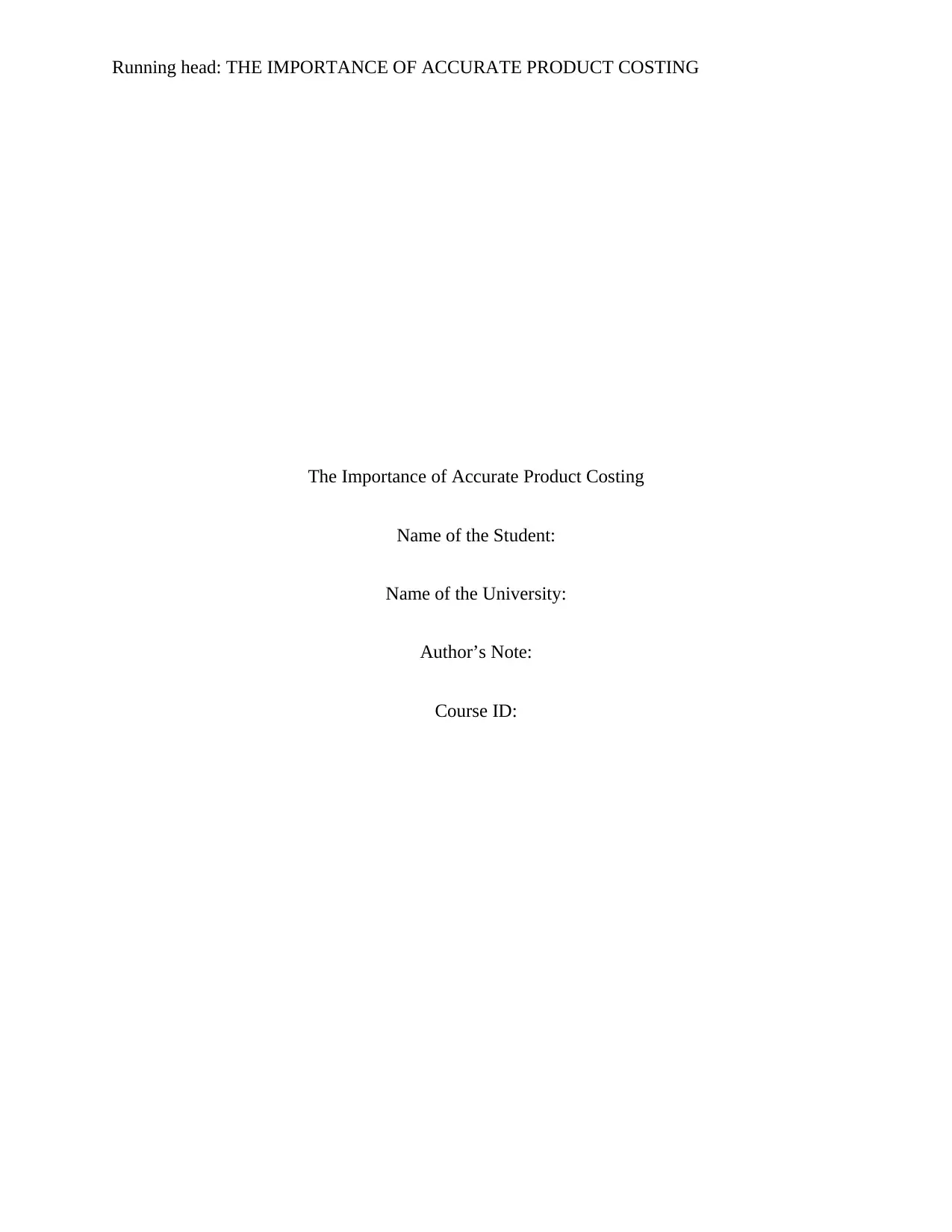
Running head: THE IMPORTANCE OF ACCURATE PRODUCT COSTING
The Importance of Accurate Product Costing
Name of the Student:
Name of the University:
Author’s Note:
Course ID:
The Importance of Accurate Product Costing
Name of the Student:
Name of the University:
Author’s Note:
Course ID:
Secure Best Marks with AI Grader
Need help grading? Try our AI Grader for instant feedback on your assignments.
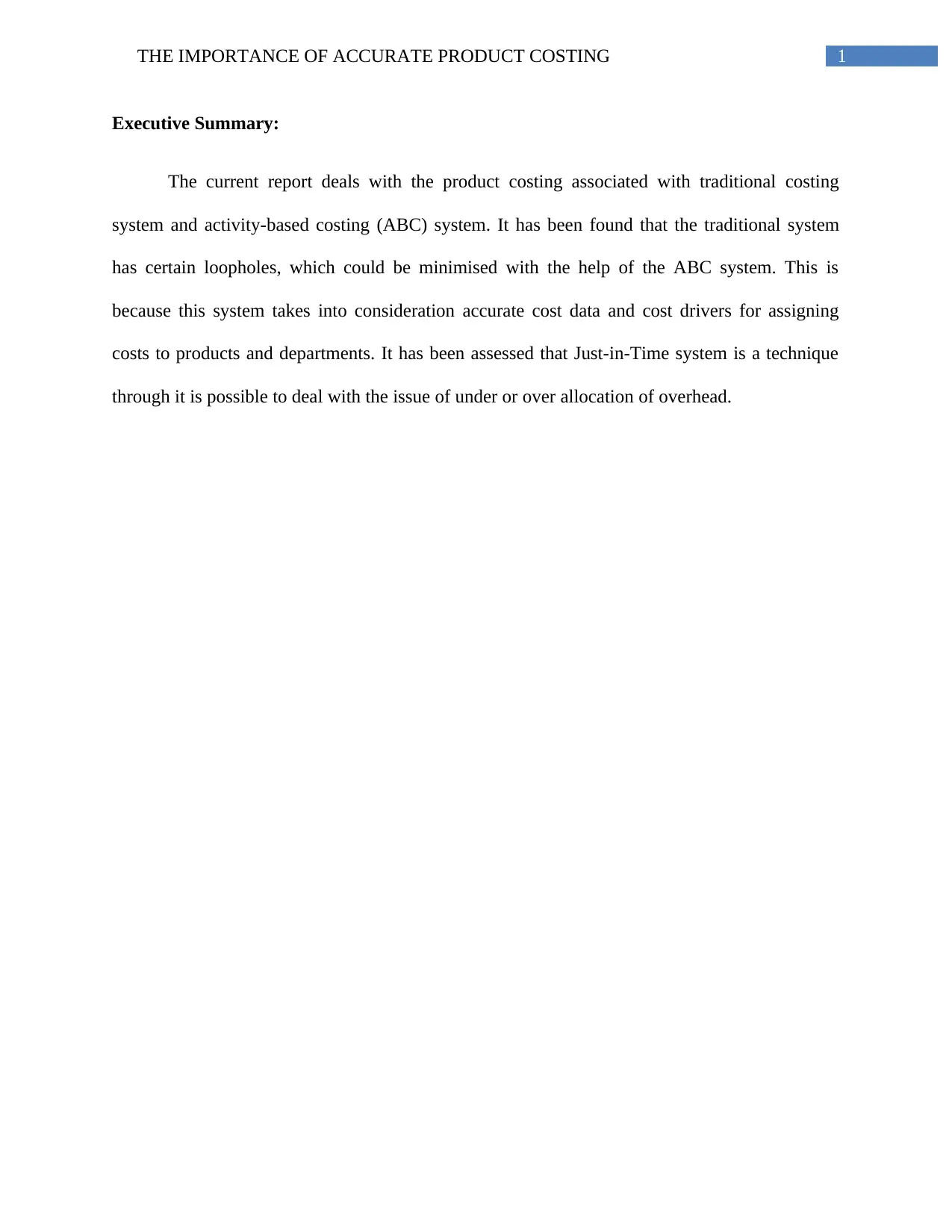
1THE IMPORTANCE OF ACCURATE PRODUCT COSTING
Executive Summary:
The current report deals with the product costing associated with traditional costing
system and activity-based costing (ABC) system. It has been found that the traditional system
has certain loopholes, which could be minimised with the help of the ABC system. This is
because this system takes into consideration accurate cost data and cost drivers for assigning
costs to products and departments. It has been assessed that Just-in-Time system is a technique
through it is possible to deal with the issue of under or over allocation of overhead.
Executive Summary:
The current report deals with the product costing associated with traditional costing
system and activity-based costing (ABC) system. It has been found that the traditional system
has certain loopholes, which could be minimised with the help of the ABC system. This is
because this system takes into consideration accurate cost data and cost drivers for assigning
costs to products and departments. It has been assessed that Just-in-Time system is a technique
through it is possible to deal with the issue of under or over allocation of overhead.
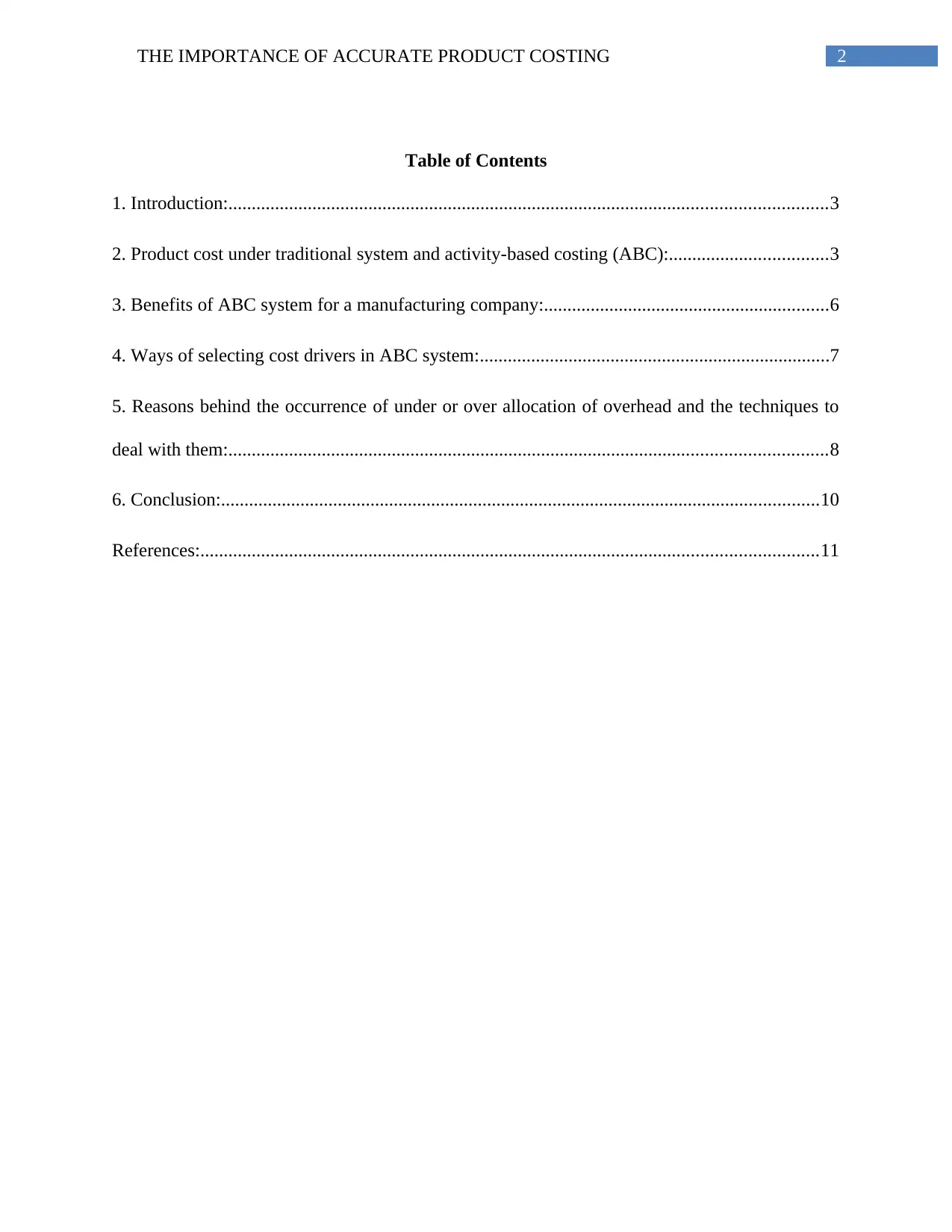
2THE IMPORTANCE OF ACCURATE PRODUCT COSTING
Table of Contents
1. Introduction:................................................................................................................................3
2. Product cost under traditional system and activity-based costing (ABC):..................................3
3. Benefits of ABC system for a manufacturing company:.............................................................6
4. Ways of selecting cost drivers in ABC system:...........................................................................7
5. Reasons behind the occurrence of under or over allocation of overhead and the techniques to
deal with them:................................................................................................................................8
6. Conclusion:................................................................................................................................10
References:....................................................................................................................................11
Table of Contents
1. Introduction:................................................................................................................................3
2. Product cost under traditional system and activity-based costing (ABC):..................................3
3. Benefits of ABC system for a manufacturing company:.............................................................6
4. Ways of selecting cost drivers in ABC system:...........................................................................7
5. Reasons behind the occurrence of under or over allocation of overhead and the techniques to
deal with them:................................................................................................................................8
6. Conclusion:................................................................................................................................10
References:....................................................................................................................................11
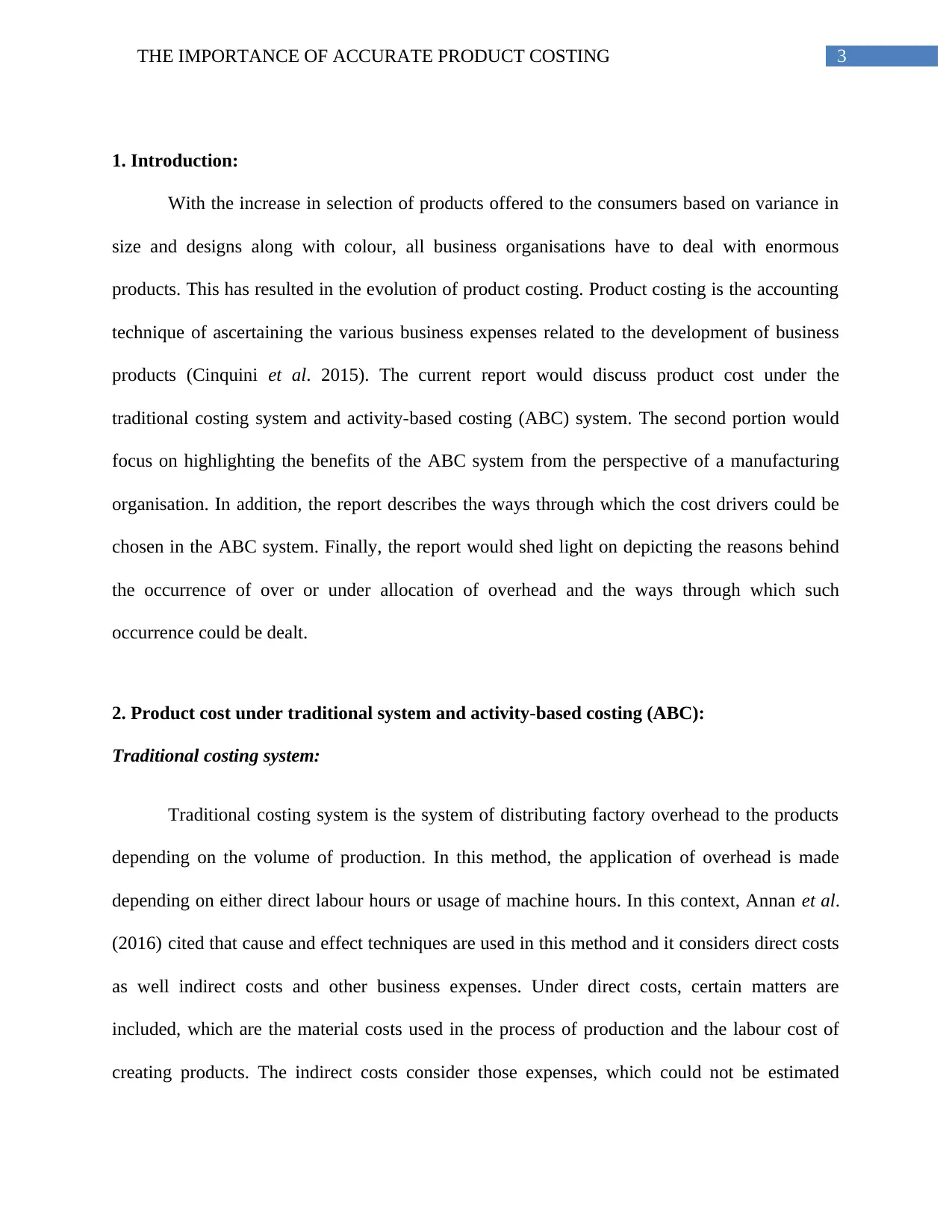
3THE IMPORTANCE OF ACCURATE PRODUCT COSTING
1. Introduction:
With the increase in selection of products offered to the consumers based on variance in
size and designs along with colour, all business organisations have to deal with enormous
products. This has resulted in the evolution of product costing. Product costing is the accounting
technique of ascertaining the various business expenses related to the development of business
products (Cinquini et al. 2015). The current report would discuss product cost under the
traditional costing system and activity-based costing (ABC) system. The second portion would
focus on highlighting the benefits of the ABC system from the perspective of a manufacturing
organisation. In addition, the report describes the ways through which the cost drivers could be
chosen in the ABC system. Finally, the report would shed light on depicting the reasons behind
the occurrence of over or under allocation of overhead and the ways through which such
occurrence could be dealt.
2. Product cost under traditional system and activity-based costing (ABC):
Traditional costing system:
Traditional costing system is the system of distributing factory overhead to the products
depending on the volume of production. In this method, the application of overhead is made
depending on either direct labour hours or usage of machine hours. In this context, Annan et al.
(2016) cited that cause and effect techniques are used in this method and it considers direct costs
as well indirect costs and other business expenses. Under direct costs, certain matters are
included, which are the material costs used in the process of production and the labour cost of
creating products. The indirect costs consider those expenses, which could not be estimated
1. Introduction:
With the increase in selection of products offered to the consumers based on variance in
size and designs along with colour, all business organisations have to deal with enormous
products. This has resulted in the evolution of product costing. Product costing is the accounting
technique of ascertaining the various business expenses related to the development of business
products (Cinquini et al. 2015). The current report would discuss product cost under the
traditional costing system and activity-based costing (ABC) system. The second portion would
focus on highlighting the benefits of the ABC system from the perspective of a manufacturing
organisation. In addition, the report describes the ways through which the cost drivers could be
chosen in the ABC system. Finally, the report would shed light on depicting the reasons behind
the occurrence of over or under allocation of overhead and the ways through which such
occurrence could be dealt.
2. Product cost under traditional system and activity-based costing (ABC):
Traditional costing system:
Traditional costing system is the system of distributing factory overhead to the products
depending on the volume of production. In this method, the application of overhead is made
depending on either direct labour hours or usage of machine hours. In this context, Annan et al.
(2016) cited that cause and effect techniques are used in this method and it considers direct costs
as well indirect costs and other business expenses. Under direct costs, certain matters are
included, which are the material costs used in the process of production and the labour cost of
creating products. The indirect costs consider those expenses, which could not be estimated
Secure Best Marks with AI Grader
Need help grading? Try our AI Grader for instant feedback on your assignments.
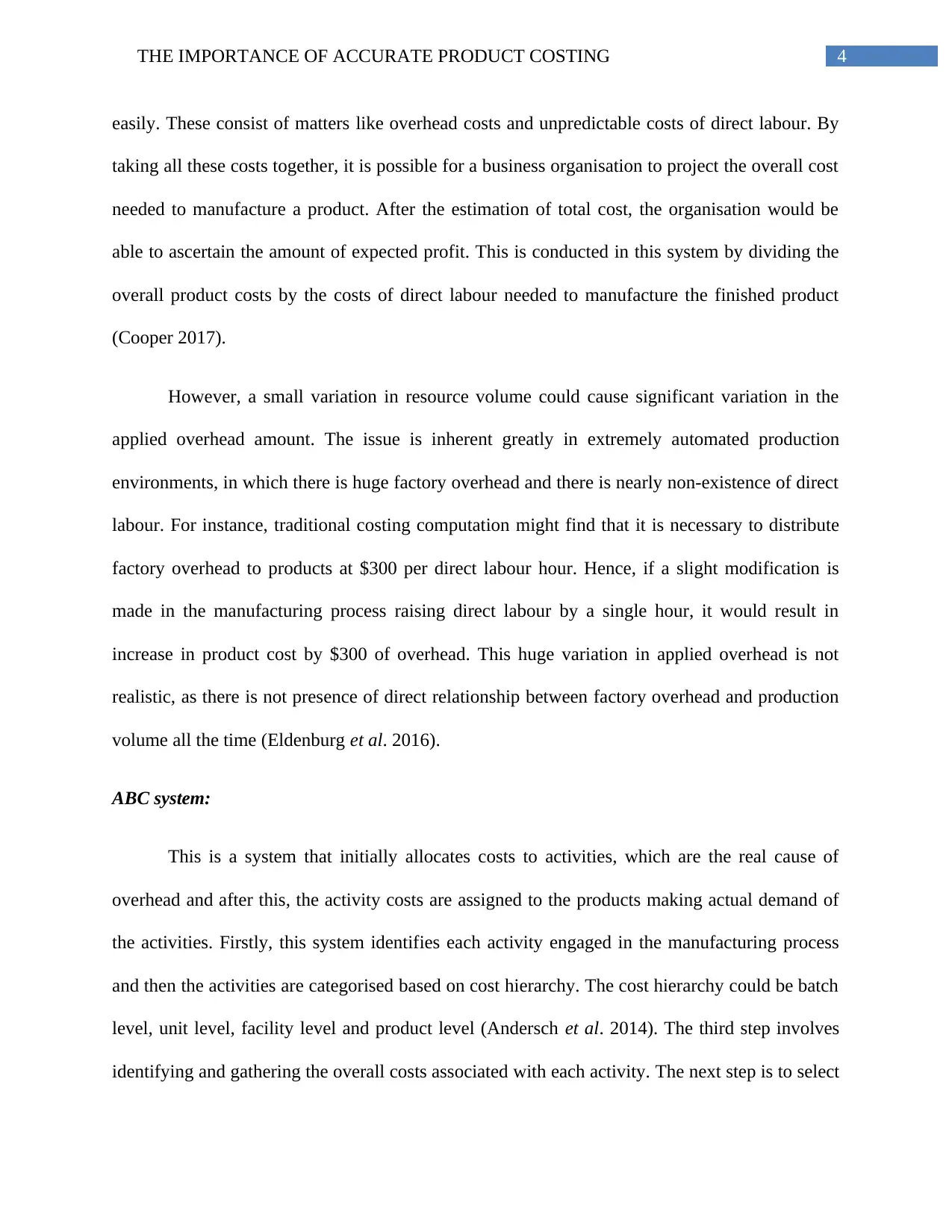
4THE IMPORTANCE OF ACCURATE PRODUCT COSTING
easily. These consist of matters like overhead costs and unpredictable costs of direct labour. By
taking all these costs together, it is possible for a business organisation to project the overall cost
needed to manufacture a product. After the estimation of total cost, the organisation would be
able to ascertain the amount of expected profit. This is conducted in this system by dividing the
overall product costs by the costs of direct labour needed to manufacture the finished product
(Cooper 2017).
However, a small variation in resource volume could cause significant variation in the
applied overhead amount. The issue is inherent greatly in extremely automated production
environments, in which there is huge factory overhead and there is nearly non-existence of direct
labour. For instance, traditional costing computation might find that it is necessary to distribute
factory overhead to products at $300 per direct labour hour. Hence, if a slight modification is
made in the manufacturing process raising direct labour by a single hour, it would result in
increase in product cost by $300 of overhead. This huge variation in applied overhead is not
realistic, as there is not presence of direct relationship between factory overhead and production
volume all the time (Eldenburg et al. 2016).
ABC system:
This is a system that initially allocates costs to activities, which are the real cause of
overhead and after this, the activity costs are assigned to the products making actual demand of
the activities. Firstly, this system identifies each activity engaged in the manufacturing process
and then the activities are categorised based on cost hierarchy. The cost hierarchy could be batch
level, unit level, facility level and product level (Andersch et al. 2014). The third step involves
identifying and gathering the overall costs associated with each activity. The next step is to select
easily. These consist of matters like overhead costs and unpredictable costs of direct labour. By
taking all these costs together, it is possible for a business organisation to project the overall cost
needed to manufacture a product. After the estimation of total cost, the organisation would be
able to ascertain the amount of expected profit. This is conducted in this system by dividing the
overall product costs by the costs of direct labour needed to manufacture the finished product
(Cooper 2017).
However, a small variation in resource volume could cause significant variation in the
applied overhead amount. The issue is inherent greatly in extremely automated production
environments, in which there is huge factory overhead and there is nearly non-existence of direct
labour. For instance, traditional costing computation might find that it is necessary to distribute
factory overhead to products at $300 per direct labour hour. Hence, if a slight modification is
made in the manufacturing process raising direct labour by a single hour, it would result in
increase in product cost by $300 of overhead. This huge variation in applied overhead is not
realistic, as there is not presence of direct relationship between factory overhead and production
volume all the time (Eldenburg et al. 2016).
ABC system:
This is a system that initially allocates costs to activities, which are the real cause of
overhead and after this, the activity costs are assigned to the products making actual demand of
the activities. Firstly, this system identifies each activity engaged in the manufacturing process
and then the activities are categorised based on cost hierarchy. The cost hierarchy could be batch
level, unit level, facility level and product level (Andersch et al. 2014). The third step involves
identifying and gathering the overall costs associated with each activity. The next step is to select
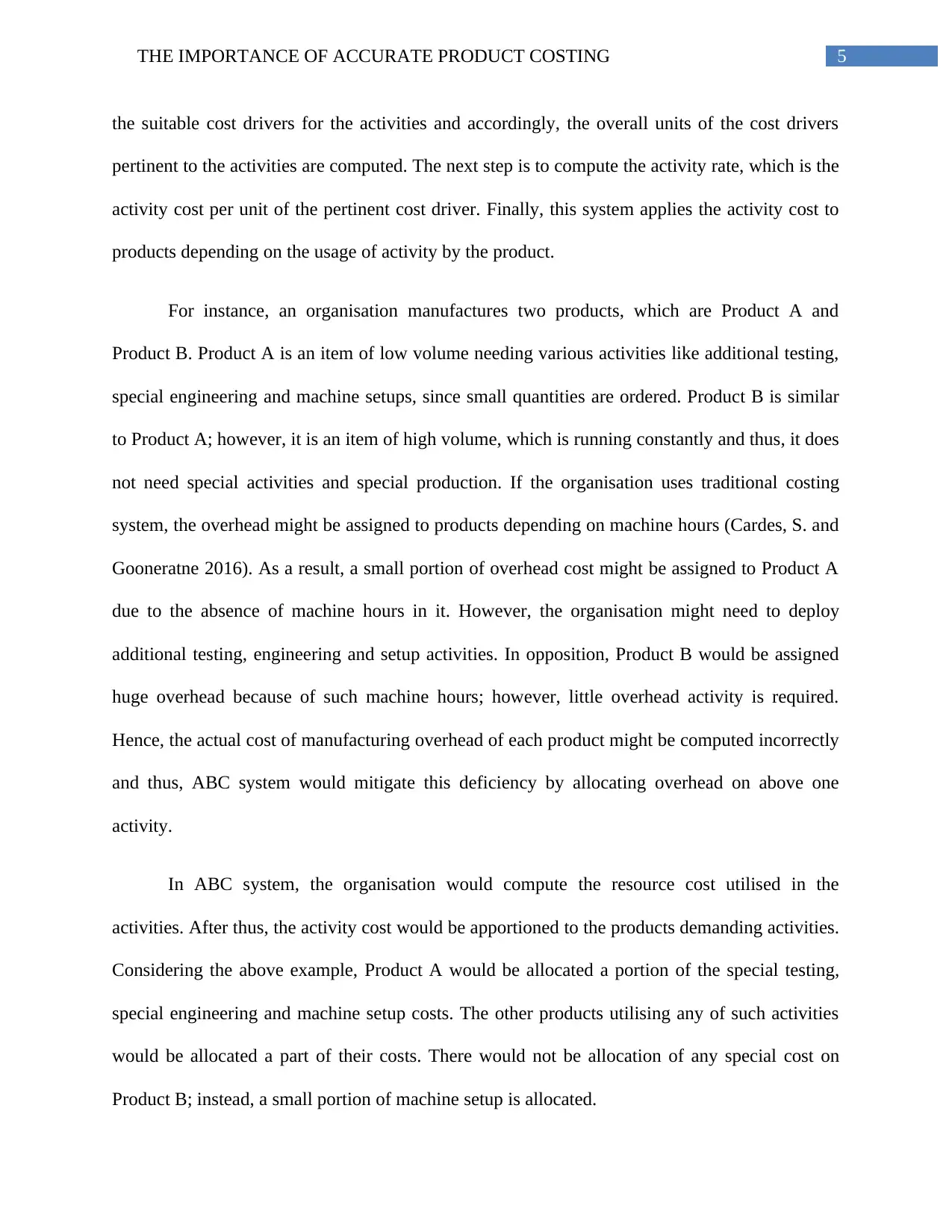
5THE IMPORTANCE OF ACCURATE PRODUCT COSTING
the suitable cost drivers for the activities and accordingly, the overall units of the cost drivers
pertinent to the activities are computed. The next step is to compute the activity rate, which is the
activity cost per unit of the pertinent cost driver. Finally, this system applies the activity cost to
products depending on the usage of activity by the product.
For instance, an organisation manufactures two products, which are Product A and
Product B. Product A is an item of low volume needing various activities like additional testing,
special engineering and machine setups, since small quantities are ordered. Product B is similar
to Product A; however, it is an item of high volume, which is running constantly and thus, it does
not need special activities and special production. If the organisation uses traditional costing
system, the overhead might be assigned to products depending on machine hours (Cardes, S. and
Gooneratne 2016). As a result, a small portion of overhead cost might be assigned to Product A
due to the absence of machine hours in it. However, the organisation might need to deploy
additional testing, engineering and setup activities. In opposition, Product B would be assigned
huge overhead because of such machine hours; however, little overhead activity is required.
Hence, the actual cost of manufacturing overhead of each product might be computed incorrectly
and thus, ABC system would mitigate this deficiency by allocating overhead on above one
activity.
In ABC system, the organisation would compute the resource cost utilised in the
activities. After thus, the activity cost would be apportioned to the products demanding activities.
Considering the above example, Product A would be allocated a portion of the special testing,
special engineering and machine setup costs. The other products utilising any of such activities
would be allocated a part of their costs. There would not be allocation of any special cost on
Product B; instead, a small portion of machine setup is allocated.
the suitable cost drivers for the activities and accordingly, the overall units of the cost drivers
pertinent to the activities are computed. The next step is to compute the activity rate, which is the
activity cost per unit of the pertinent cost driver. Finally, this system applies the activity cost to
products depending on the usage of activity by the product.
For instance, an organisation manufactures two products, which are Product A and
Product B. Product A is an item of low volume needing various activities like additional testing,
special engineering and machine setups, since small quantities are ordered. Product B is similar
to Product A; however, it is an item of high volume, which is running constantly and thus, it does
not need special activities and special production. If the organisation uses traditional costing
system, the overhead might be assigned to products depending on machine hours (Cardes, S. and
Gooneratne 2016). As a result, a small portion of overhead cost might be assigned to Product A
due to the absence of machine hours in it. However, the organisation might need to deploy
additional testing, engineering and setup activities. In opposition, Product B would be assigned
huge overhead because of such machine hours; however, little overhead activity is required.
Hence, the actual cost of manufacturing overhead of each product might be computed incorrectly
and thus, ABC system would mitigate this deficiency by allocating overhead on above one
activity.
In ABC system, the organisation would compute the resource cost utilised in the
activities. After thus, the activity cost would be apportioned to the products demanding activities.
Considering the above example, Product A would be allocated a portion of the special testing,
special engineering and machine setup costs. The other products utilising any of such activities
would be allocated a part of their costs. There would not be allocation of any special cost on
Product B; instead, a small portion of machine setup is allocated.
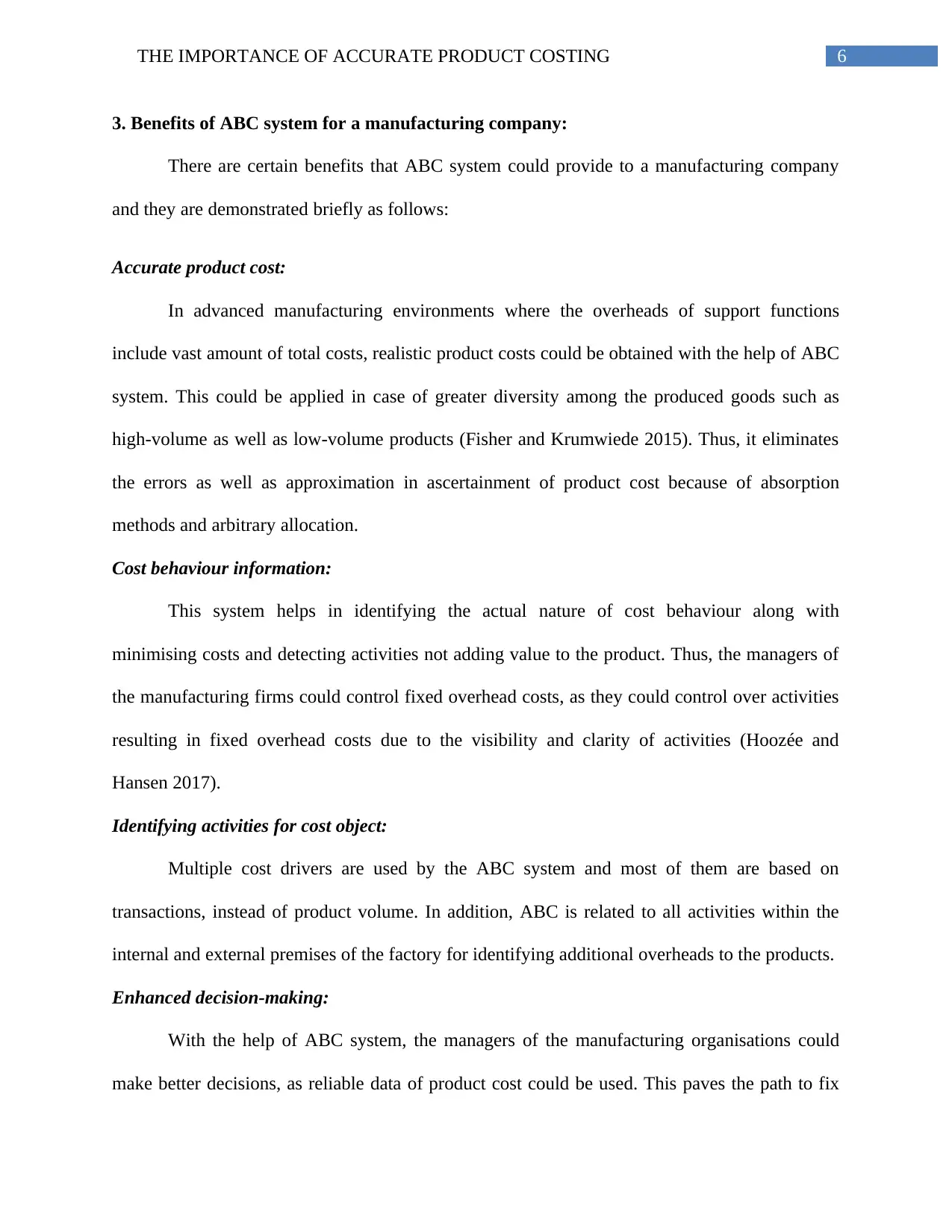
6THE IMPORTANCE OF ACCURATE PRODUCT COSTING
3. Benefits of ABC system for a manufacturing company:
There are certain benefits that ABC system could provide to a manufacturing company
and they are demonstrated briefly as follows:
Accurate product cost:
In advanced manufacturing environments where the overheads of support functions
include vast amount of total costs, realistic product costs could be obtained with the help of ABC
system. This could be applied in case of greater diversity among the produced goods such as
high-volume as well as low-volume products (Fisher and Krumwiede 2015). Thus, it eliminates
the errors as well as approximation in ascertainment of product cost because of absorption
methods and arbitrary allocation.
Cost behaviour information:
This system helps in identifying the actual nature of cost behaviour along with
minimising costs and detecting activities not adding value to the product. Thus, the managers of
the manufacturing firms could control fixed overhead costs, as they could control over activities
resulting in fixed overhead costs due to the visibility and clarity of activities (Hoozée and
Hansen 2017).
Identifying activities for cost object:
Multiple cost drivers are used by the ABC system and most of them are based on
transactions, instead of product volume. In addition, ABC is related to all activities within the
internal and external premises of the factory for identifying additional overheads to the products.
Enhanced decision-making:
With the help of ABC system, the managers of the manufacturing organisations could
make better decisions, as reliable data of product cost could be used. This paves the path to fix
3. Benefits of ABC system for a manufacturing company:
There are certain benefits that ABC system could provide to a manufacturing company
and they are demonstrated briefly as follows:
Accurate product cost:
In advanced manufacturing environments where the overheads of support functions
include vast amount of total costs, realistic product costs could be obtained with the help of ABC
system. This could be applied in case of greater diversity among the produced goods such as
high-volume as well as low-volume products (Fisher and Krumwiede 2015). Thus, it eliminates
the errors as well as approximation in ascertainment of product cost because of absorption
methods and arbitrary allocation.
Cost behaviour information:
This system helps in identifying the actual nature of cost behaviour along with
minimising costs and detecting activities not adding value to the product. Thus, the managers of
the manufacturing firms could control fixed overhead costs, as they could control over activities
resulting in fixed overhead costs due to the visibility and clarity of activities (Hoozée and
Hansen 2017).
Identifying activities for cost object:
Multiple cost drivers are used by the ABC system and most of them are based on
transactions, instead of product volume. In addition, ABC is related to all activities within the
internal and external premises of the factory for identifying additional overheads to the products.
Enhanced decision-making:
With the help of ABC system, the managers of the manufacturing organisations could
make better decisions, as reliable data of product cost could be used. This paves the path to fix
Paraphrase This Document
Need a fresh take? Get an instant paraphrase of this document with our AI Paraphraser
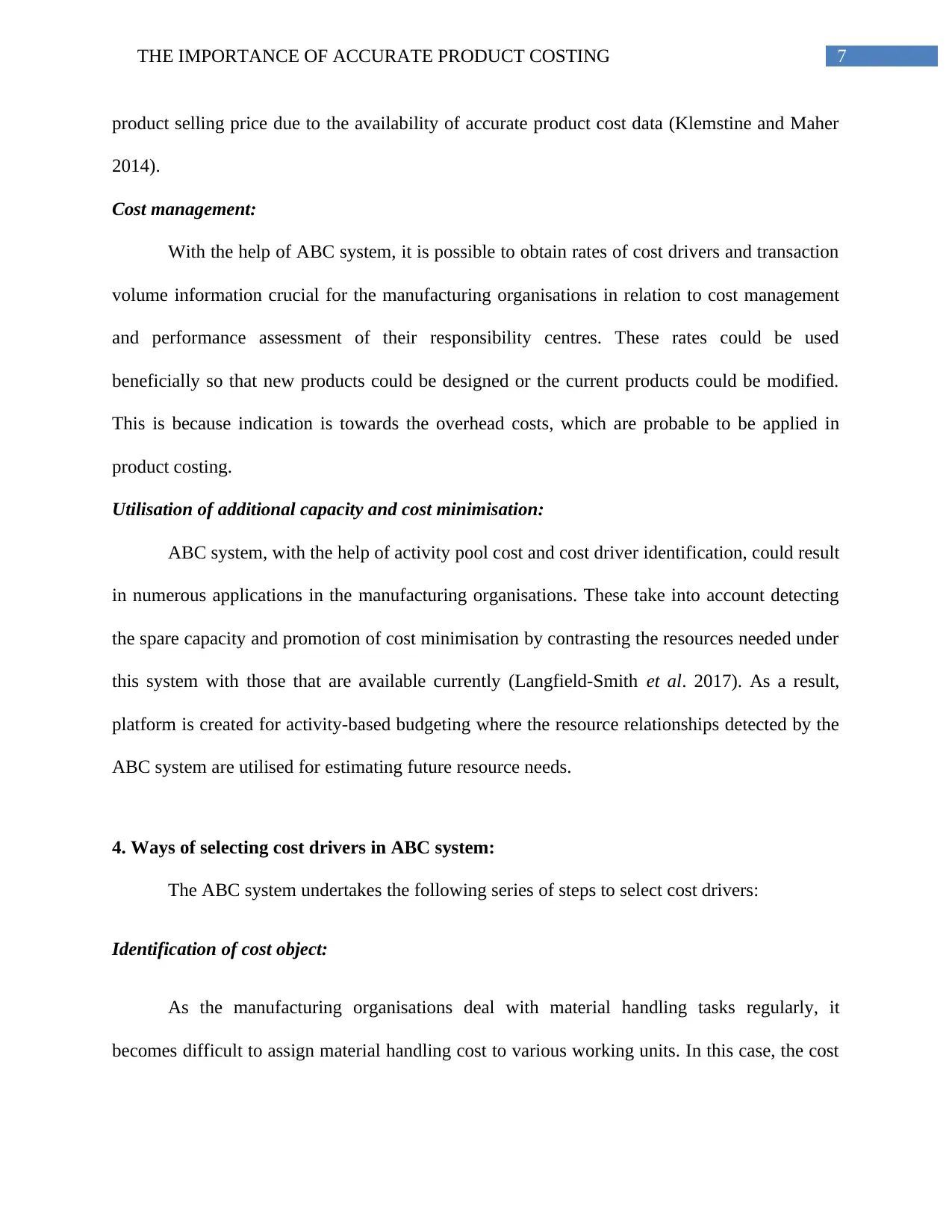
7THE IMPORTANCE OF ACCURATE PRODUCT COSTING
product selling price due to the availability of accurate product cost data (Klemstine and Maher
2014).
Cost management:
With the help of ABC system, it is possible to obtain rates of cost drivers and transaction
volume information crucial for the manufacturing organisations in relation to cost management
and performance assessment of their responsibility centres. These rates could be used
beneficially so that new products could be designed or the current products could be modified.
This is because indication is towards the overhead costs, which are probable to be applied in
product costing.
Utilisation of additional capacity and cost minimisation:
ABC system, with the help of activity pool cost and cost driver identification, could result
in numerous applications in the manufacturing organisations. These take into account detecting
the spare capacity and promotion of cost minimisation by contrasting the resources needed under
this system with those that are available currently (Langfield-Smith et al. 2017). As a result,
platform is created for activity-based budgeting where the resource relationships detected by the
ABC system are utilised for estimating future resource needs.
4. Ways of selecting cost drivers in ABC system:
The ABC system undertakes the following series of steps to select cost drivers:
Identification of cost object:
As the manufacturing organisations deal with material handling tasks regularly, it
becomes difficult to assign material handling cost to various working units. In this case, the cost
product selling price due to the availability of accurate product cost data (Klemstine and Maher
2014).
Cost management:
With the help of ABC system, it is possible to obtain rates of cost drivers and transaction
volume information crucial for the manufacturing organisations in relation to cost management
and performance assessment of their responsibility centres. These rates could be used
beneficially so that new products could be designed or the current products could be modified.
This is because indication is towards the overhead costs, which are probable to be applied in
product costing.
Utilisation of additional capacity and cost minimisation:
ABC system, with the help of activity pool cost and cost driver identification, could result
in numerous applications in the manufacturing organisations. These take into account detecting
the spare capacity and promotion of cost minimisation by contrasting the resources needed under
this system with those that are available currently (Langfield-Smith et al. 2017). As a result,
platform is created for activity-based budgeting where the resource relationships detected by the
ABC system are utilised for estimating future resource needs.
4. Ways of selecting cost drivers in ABC system:
The ABC system undertakes the following series of steps to select cost drivers:
Identification of cost object:
As the manufacturing organisations deal with material handling tasks regularly, it
becomes difficult to assign material handling cost to various working units. In this case, the cost
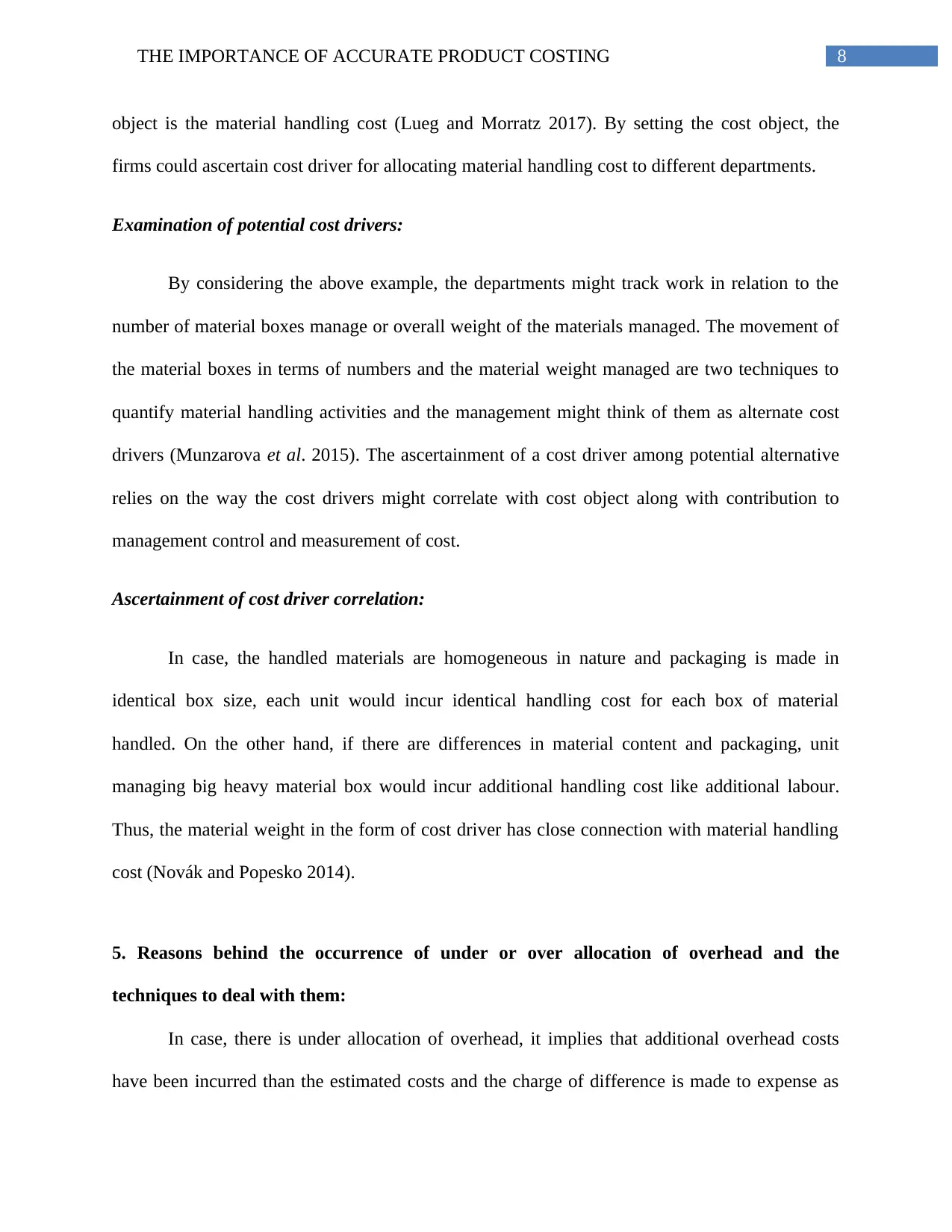
8THE IMPORTANCE OF ACCURATE PRODUCT COSTING
object is the material handling cost (Lueg and Morratz 2017). By setting the cost object, the
firms could ascertain cost driver for allocating material handling cost to different departments.
Examination of potential cost drivers:
By considering the above example, the departments might track work in relation to the
number of material boxes manage or overall weight of the materials managed. The movement of
the material boxes in terms of numbers and the material weight managed are two techniques to
quantify material handling activities and the management might think of them as alternate cost
drivers (Munzarova et al. 2015). The ascertainment of a cost driver among potential alternative
relies on the way the cost drivers might correlate with cost object along with contribution to
management control and measurement of cost.
Ascertainment of cost driver correlation:
In case, the handled materials are homogeneous in nature and packaging is made in
identical box size, each unit would incur identical handling cost for each box of material
handled. On the other hand, if there are differences in material content and packaging, unit
managing big heavy material box would incur additional handling cost like additional labour.
Thus, the material weight in the form of cost driver has close connection with material handling
cost (Novák and Popesko 2014).
5. Reasons behind the occurrence of under or over allocation of overhead and the
techniques to deal with them:
In case, there is under allocation of overhead, it implies that additional overhead costs
have been incurred than the estimated costs and the charge of difference is made to expense as
object is the material handling cost (Lueg and Morratz 2017). By setting the cost object, the
firms could ascertain cost driver for allocating material handling cost to different departments.
Examination of potential cost drivers:
By considering the above example, the departments might track work in relation to the
number of material boxes manage or overall weight of the materials managed. The movement of
the material boxes in terms of numbers and the material weight managed are two techniques to
quantify material handling activities and the management might think of them as alternate cost
drivers (Munzarova et al. 2015). The ascertainment of a cost driver among potential alternative
relies on the way the cost drivers might correlate with cost object along with contribution to
management control and measurement of cost.
Ascertainment of cost driver correlation:
In case, the handled materials are homogeneous in nature and packaging is made in
identical box size, each unit would incur identical handling cost for each box of material
handled. On the other hand, if there are differences in material content and packaging, unit
managing big heavy material box would incur additional handling cost like additional labour.
Thus, the material weight in the form of cost driver has close connection with material handling
cost (Novák and Popesko 2014).
5. Reasons behind the occurrence of under or over allocation of overhead and the
techniques to deal with them:
In case, there is under allocation of overhead, it implies that additional overhead costs
have been incurred than the estimated costs and the charge of difference is made to expense as
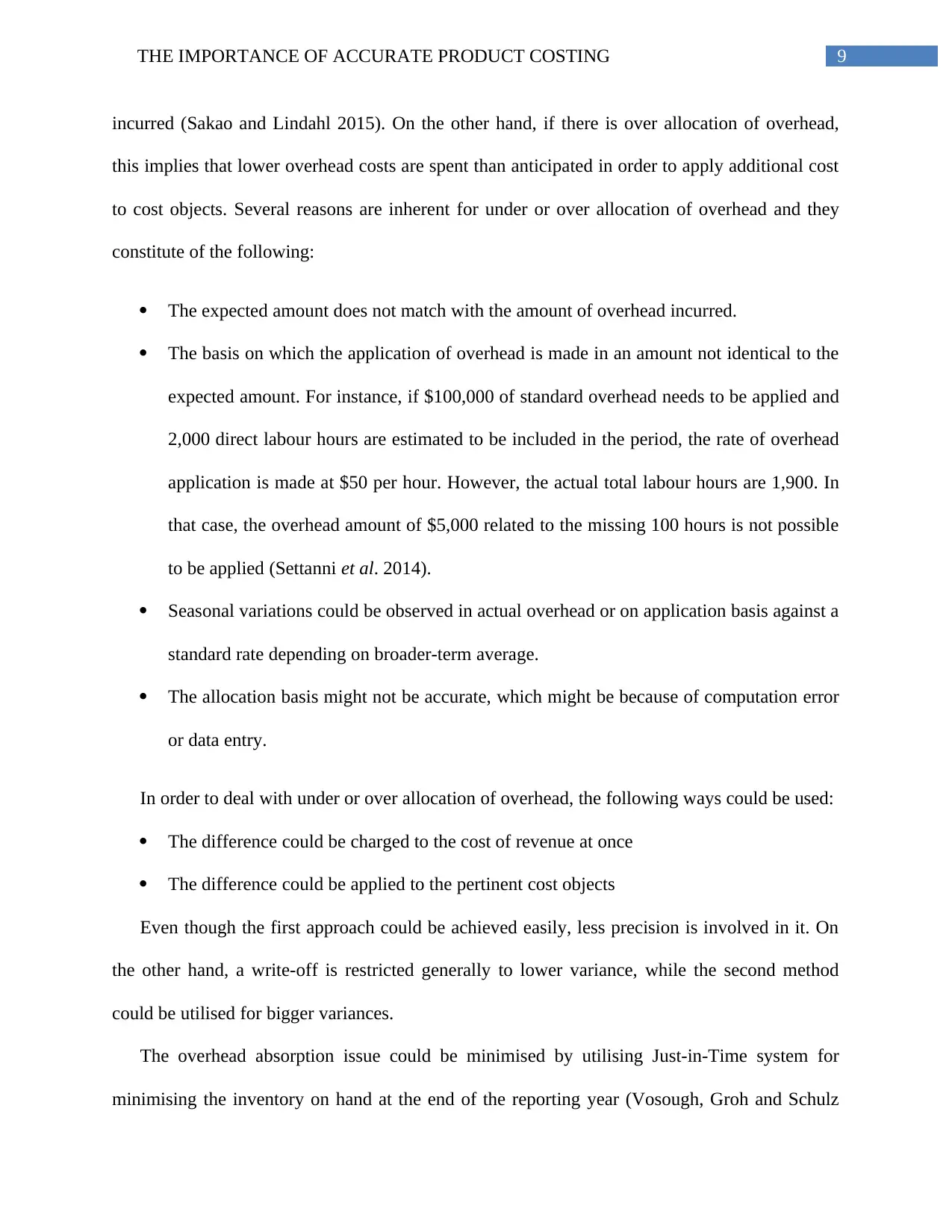
9THE IMPORTANCE OF ACCURATE PRODUCT COSTING
incurred (Sakao and Lindahl 2015). On the other hand, if there is over allocation of overhead,
this implies that lower overhead costs are spent than anticipated in order to apply additional cost
to cost objects. Several reasons are inherent for under or over allocation of overhead and they
constitute of the following:
The expected amount does not match with the amount of overhead incurred.
The basis on which the application of overhead is made in an amount not identical to the
expected amount. For instance, if $100,000 of standard overhead needs to be applied and
2,000 direct labour hours are estimated to be included in the period, the rate of overhead
application is made at $50 per hour. However, the actual total labour hours are 1,900. In
that case, the overhead amount of $5,000 related to the missing 100 hours is not possible
to be applied (Settanni et al. 2014).
Seasonal variations could be observed in actual overhead or on application basis against a
standard rate depending on broader-term average.
The allocation basis might not be accurate, which might be because of computation error
or data entry.
In order to deal with under or over allocation of overhead, the following ways could be used:
The difference could be charged to the cost of revenue at once
The difference could be applied to the pertinent cost objects
Even though the first approach could be achieved easily, less precision is involved in it. On
the other hand, a write-off is restricted generally to lower variance, while the second method
could be utilised for bigger variances.
The overhead absorption issue could be minimised by utilising Just-in-Time system for
minimising the inventory on hand at the end of the reporting year (Vosough, Groh and Schulz
incurred (Sakao and Lindahl 2015). On the other hand, if there is over allocation of overhead,
this implies that lower overhead costs are spent than anticipated in order to apply additional cost
to cost objects. Several reasons are inherent for under or over allocation of overhead and they
constitute of the following:
The expected amount does not match with the amount of overhead incurred.
The basis on which the application of overhead is made in an amount not identical to the
expected amount. For instance, if $100,000 of standard overhead needs to be applied and
2,000 direct labour hours are estimated to be included in the period, the rate of overhead
application is made at $50 per hour. However, the actual total labour hours are 1,900. In
that case, the overhead amount of $5,000 related to the missing 100 hours is not possible
to be applied (Settanni et al. 2014).
Seasonal variations could be observed in actual overhead or on application basis against a
standard rate depending on broader-term average.
The allocation basis might not be accurate, which might be because of computation error
or data entry.
In order to deal with under or over allocation of overhead, the following ways could be used:
The difference could be charged to the cost of revenue at once
The difference could be applied to the pertinent cost objects
Even though the first approach could be achieved easily, less precision is involved in it. On
the other hand, a write-off is restricted generally to lower variance, while the second method
could be utilised for bigger variances.
The overhead absorption issue could be minimised by utilising Just-in-Time system for
minimising the inventory on hand at the end of the reporting year (Vosough, Groh and Schulz
Secure Best Marks with AI Grader
Need help grading? Try our AI Grader for instant feedback on your assignments.
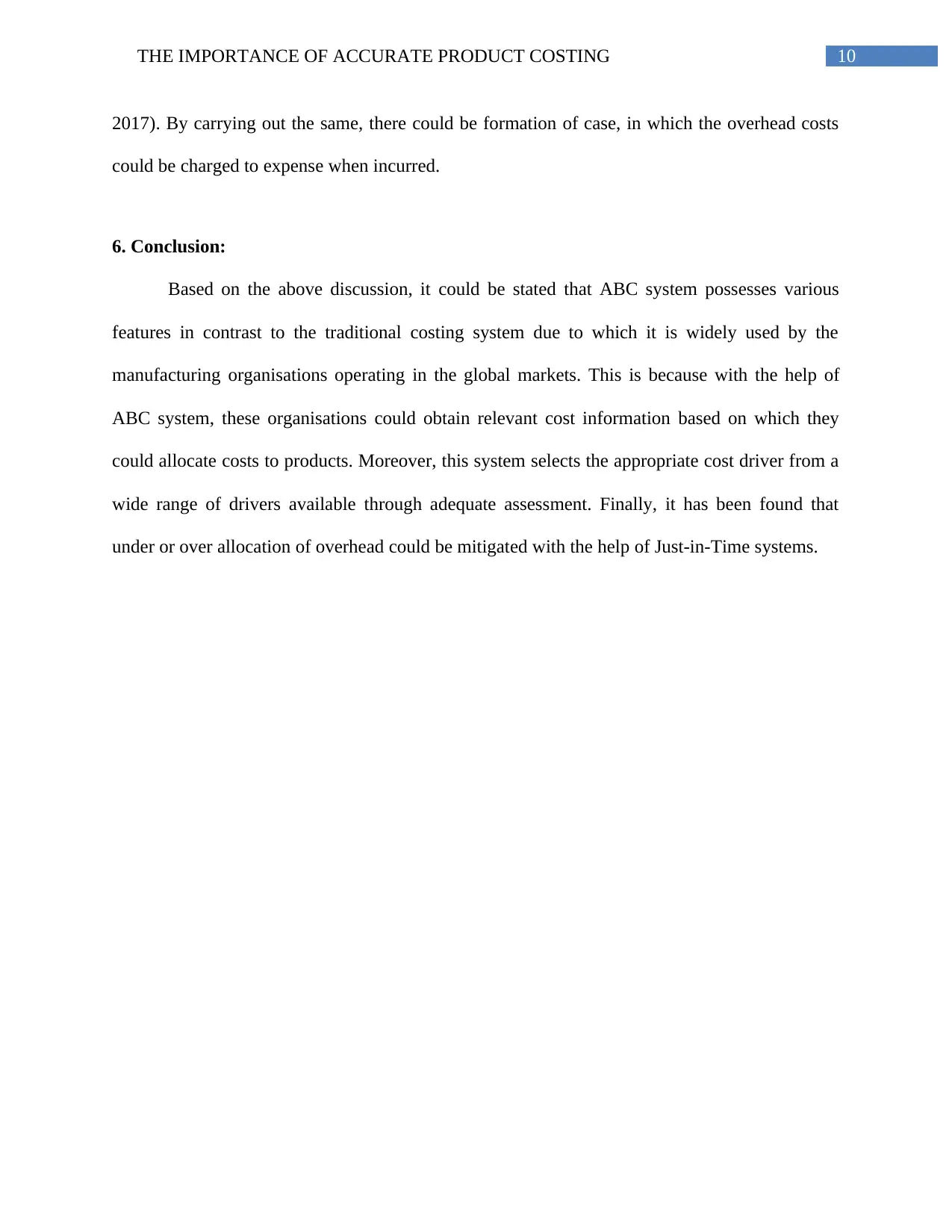
10THE IMPORTANCE OF ACCURATE PRODUCT COSTING
2017). By carrying out the same, there could be formation of case, in which the overhead costs
could be charged to expense when incurred.
6. Conclusion:
Based on the above discussion, it could be stated that ABC system possesses various
features in contrast to the traditional costing system due to which it is widely used by the
manufacturing organisations operating in the global markets. This is because with the help of
ABC system, these organisations could obtain relevant cost information based on which they
could allocate costs to products. Moreover, this system selects the appropriate cost driver from a
wide range of drivers available through adequate assessment. Finally, it has been found that
under or over allocation of overhead could be mitigated with the help of Just-in-Time systems.
2017). By carrying out the same, there could be formation of case, in which the overhead costs
could be charged to expense when incurred.
6. Conclusion:
Based on the above discussion, it could be stated that ABC system possesses various
features in contrast to the traditional costing system due to which it is widely used by the
manufacturing organisations operating in the global markets. This is because with the help of
ABC system, these organisations could obtain relevant cost information based on which they
could allocate costs to products. Moreover, this system selects the appropriate cost driver from a
wide range of drivers available through adequate assessment. Finally, it has been found that
under or over allocation of overhead could be mitigated with the help of Just-in-Time systems.
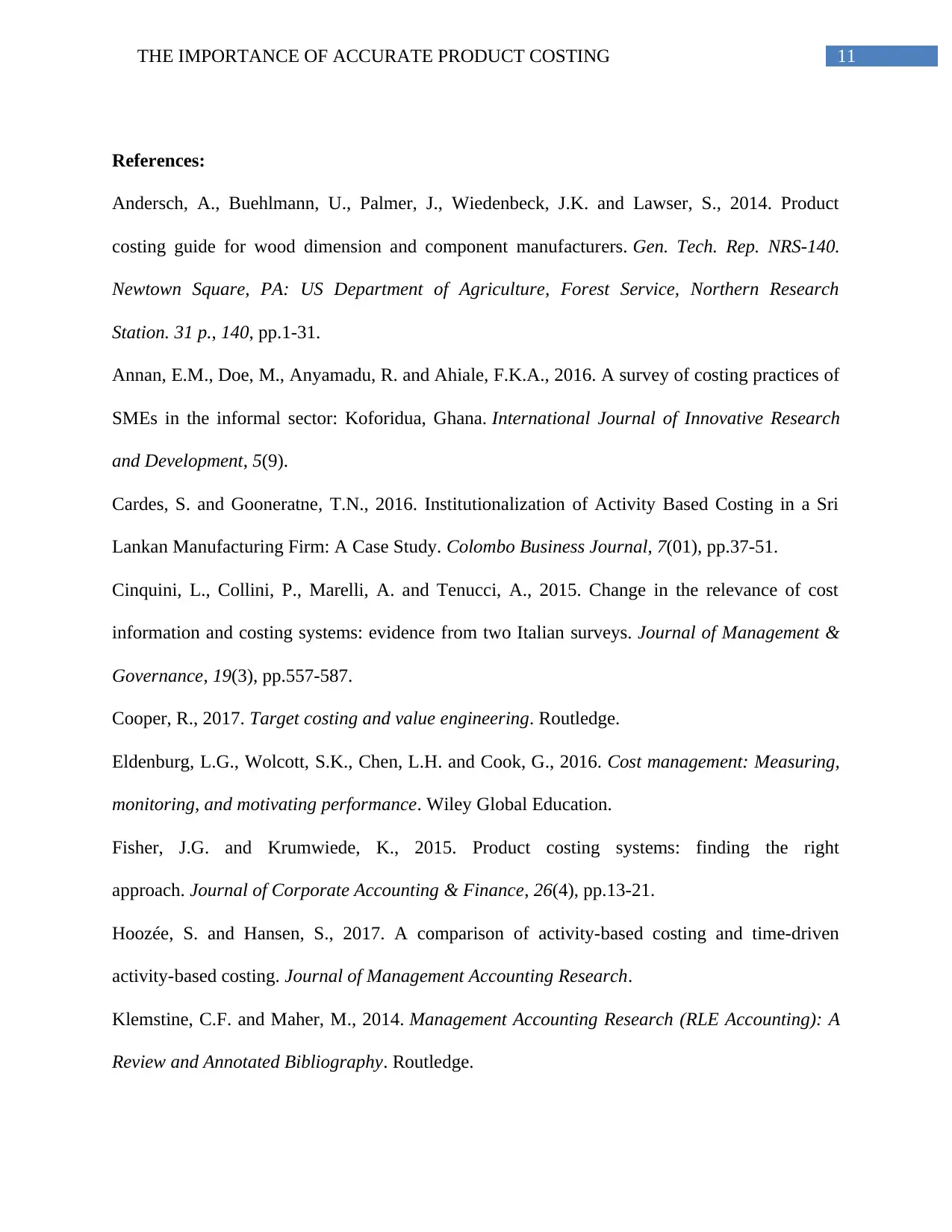
11THE IMPORTANCE OF ACCURATE PRODUCT COSTING
References:
Andersch, A., Buehlmann, U., Palmer, J., Wiedenbeck, J.K. and Lawser, S., 2014. Product
costing guide for wood dimension and component manufacturers. Gen. Tech. Rep. NRS-140.
Newtown Square, PA: US Department of Agriculture, Forest Service, Northern Research
Station. 31 p., 140, pp.1-31.
Annan, E.M., Doe, M., Anyamadu, R. and Ahiale, F.K.A., 2016. A survey of costing practices of
SMEs in the informal sector: Koforidua, Ghana. International Journal of Innovative Research
and Development, 5(9).
Cardes, S. and Gooneratne, T.N., 2016. Institutionalization of Activity Based Costing in a Sri
Lankan Manufacturing Firm: A Case Study. Colombo Business Journal, 7(01), pp.37-51.
Cinquini, L., Collini, P., Marelli, A. and Tenucci, A., 2015. Change in the relevance of cost
information and costing systems: evidence from two Italian surveys. Journal of Management &
Governance, 19(3), pp.557-587.
Cooper, R., 2017. Target costing and value engineering. Routledge.
Eldenburg, L.G., Wolcott, S.K., Chen, L.H. and Cook, G., 2016. Cost management: Measuring,
monitoring, and motivating performance. Wiley Global Education.
Fisher, J.G. and Krumwiede, K., 2015. Product costing systems: finding the right
approach. Journal of Corporate Accounting & Finance, 26(4), pp.13-21.
Hoozée, S. and Hansen, S., 2017. A comparison of activity-based costing and time-driven
activity-based costing. Journal of Management Accounting Research.
Klemstine, C.F. and Maher, M., 2014. Management Accounting Research (RLE Accounting): A
Review and Annotated Bibliography. Routledge.
References:
Andersch, A., Buehlmann, U., Palmer, J., Wiedenbeck, J.K. and Lawser, S., 2014. Product
costing guide for wood dimension and component manufacturers. Gen. Tech. Rep. NRS-140.
Newtown Square, PA: US Department of Agriculture, Forest Service, Northern Research
Station. 31 p., 140, pp.1-31.
Annan, E.M., Doe, M., Anyamadu, R. and Ahiale, F.K.A., 2016. A survey of costing practices of
SMEs in the informal sector: Koforidua, Ghana. International Journal of Innovative Research
and Development, 5(9).
Cardes, S. and Gooneratne, T.N., 2016. Institutionalization of Activity Based Costing in a Sri
Lankan Manufacturing Firm: A Case Study. Colombo Business Journal, 7(01), pp.37-51.
Cinquini, L., Collini, P., Marelli, A. and Tenucci, A., 2015. Change in the relevance of cost
information and costing systems: evidence from two Italian surveys. Journal of Management &
Governance, 19(3), pp.557-587.
Cooper, R., 2017. Target costing and value engineering. Routledge.
Eldenburg, L.G., Wolcott, S.K., Chen, L.H. and Cook, G., 2016. Cost management: Measuring,
monitoring, and motivating performance. Wiley Global Education.
Fisher, J.G. and Krumwiede, K., 2015. Product costing systems: finding the right
approach. Journal of Corporate Accounting & Finance, 26(4), pp.13-21.
Hoozée, S. and Hansen, S., 2017. A comparison of activity-based costing and time-driven
activity-based costing. Journal of Management Accounting Research.
Klemstine, C.F. and Maher, M., 2014. Management Accounting Research (RLE Accounting): A
Review and Annotated Bibliography. Routledge.
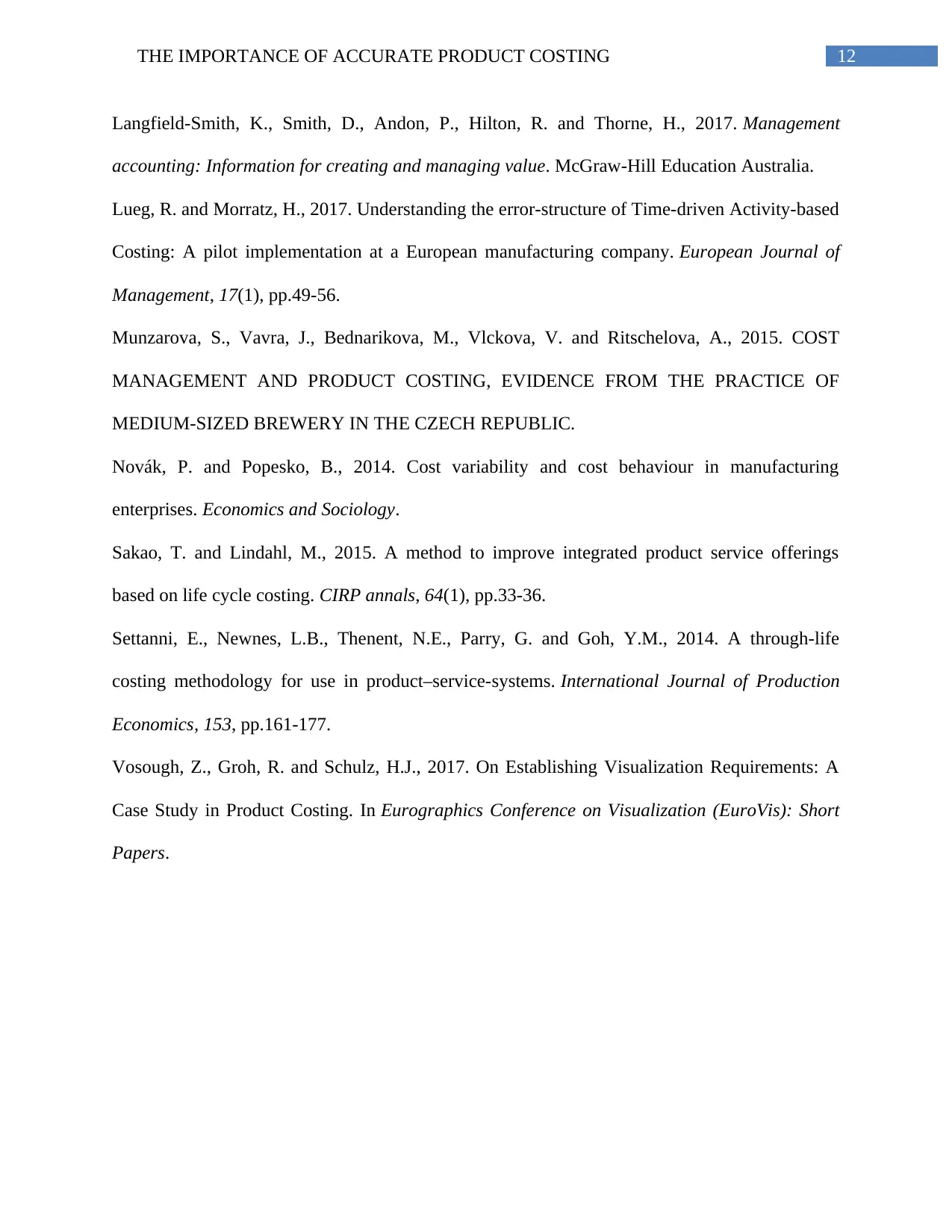
12THE IMPORTANCE OF ACCURATE PRODUCT COSTING
Langfield-Smith, K., Smith, D., Andon, P., Hilton, R. and Thorne, H., 2017. Management
accounting: Information for creating and managing value. McGraw-Hill Education Australia.
Lueg, R. and Morratz, H., 2017. Understanding the error-structure of Time-driven Activity-based
Costing: A pilot implementation at a European manufacturing company. European Journal of
Management, 17(1), pp.49-56.
Munzarova, S., Vavra, J., Bednarikova, M., Vlckova, V. and Ritschelova, A., 2015. COST
MANAGEMENT AND PRODUCT COSTING, EVIDENCE FROM THE PRACTICE OF
MEDIUM-SIZED BREWERY IN THE CZECH REPUBLIC.
Novák, P. and Popesko, B., 2014. Cost variability and cost behaviour in manufacturing
enterprises. Economics and Sociology.
Sakao, T. and Lindahl, M., 2015. A method to improve integrated product service offerings
based on life cycle costing. CIRP annals, 64(1), pp.33-36.
Settanni, E., Newnes, L.B., Thenent, N.E., Parry, G. and Goh, Y.M., 2014. A through-life
costing methodology for use in product–service-systems. International Journal of Production
Economics, 153, pp.161-177.
Vosough, Z., Groh, R. and Schulz, H.J., 2017. On Establishing Visualization Requirements: A
Case Study in Product Costing. In Eurographics Conference on Visualization (EuroVis): Short
Papers.
Langfield-Smith, K., Smith, D., Andon, P., Hilton, R. and Thorne, H., 2017. Management
accounting: Information for creating and managing value. McGraw-Hill Education Australia.
Lueg, R. and Morratz, H., 2017. Understanding the error-structure of Time-driven Activity-based
Costing: A pilot implementation at a European manufacturing company. European Journal of
Management, 17(1), pp.49-56.
Munzarova, S., Vavra, J., Bednarikova, M., Vlckova, V. and Ritschelova, A., 2015. COST
MANAGEMENT AND PRODUCT COSTING, EVIDENCE FROM THE PRACTICE OF
MEDIUM-SIZED BREWERY IN THE CZECH REPUBLIC.
Novák, P. and Popesko, B., 2014. Cost variability and cost behaviour in manufacturing
enterprises. Economics and Sociology.
Sakao, T. and Lindahl, M., 2015. A method to improve integrated product service offerings
based on life cycle costing. CIRP annals, 64(1), pp.33-36.
Settanni, E., Newnes, L.B., Thenent, N.E., Parry, G. and Goh, Y.M., 2014. A through-life
costing methodology for use in product–service-systems. International Journal of Production
Economics, 153, pp.161-177.
Vosough, Z., Groh, R. and Schulz, H.J., 2017. On Establishing Visualization Requirements: A
Case Study in Product Costing. In Eurographics Conference on Visualization (EuroVis): Short
Papers.
1 out of 13
Related Documents
Your All-in-One AI-Powered Toolkit for Academic Success.
+13062052269
info@desklib.com
Available 24*7 on WhatsApp / Email
![[object Object]](/_next/static/media/star-bottom.7253800d.svg)
Unlock your academic potential
© 2024 | Zucol Services PVT LTD | All rights reserved.





